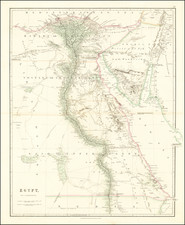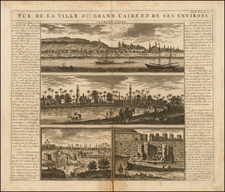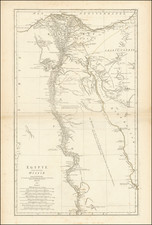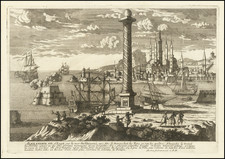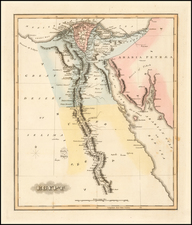Highly detailed map of the course of the Nile, compiled by William Martin Leake, a leading British authority on the topography of the region.
In March 1802, Leake was employed to make a general survey of Egypt together with W.R. Hamilton and Charles Hayes. On his return to England, his ship sank and all Leake's valuable notes on the Egyptian survey perished. His chart was subsequently published in 1818 after his retirement, incorporating additional material from Sir Alexander Bryce, M. Nouet, and others.
Leake's map provides extensive information on the Nile, ancient ruins, the Suez Canal, roads and railways, and is filled with voluminous notations. It extends south to Aswan, and beyond in an inset, as far as Dongola. First published by John Arrowsmith, this edition is by Edward Stanford. Dissected and backed with linen with paper labels containing a catalog of Stanford's Library Maps and the vendor label of G. G. Zacharia & Co. THE ENGLISH LIBRARY. Booksellers, Stationers, Photographers, etc. Opposite Cook's Office, Cairo. Complete with original cloth covered slipcase.
Map, very good with light and evenly toned with a couple of short linen splits at edges. Case in fair condition with some chipping and bottom split, which could easily be repaired.
The Arrowsmiths were a cartographic dynasty which operated from the late-eighteenth century to the mid-nineteenth. The family business was founded by Aaron Arrowsmith (1750-1823), who was renowned for carefully prepared and meticulously updated maps, globes, and charts. He created many maps that covered multiple sheets and which were massive in total size. His spare yet exacting style was recognized around the world and mapmakers from other countries, especially the young country of the United States, sought his maps and charts as exemplars for their own work.
Aaron Arrowsmith was born in County Durham in 1750. He came to London for work around 1770, where he found employment as a surveyor for the city’s mapmakers. By 1790, he had set up his own shop which specialized in general charts. Arrowsmith had five premises in his career, most of which were located on or near Soho Square, a neighborhood the led him to rub shoulders with the likes of Joseph Banks, the naturalist, and Matthew Flinders, the hydrographer.
Through his business ties and employment at the Hydrographic Office, Arrowsmith made other important relationships with Alexander Dalrymple, the Hudson’s Bay Company, and others entities. In 1810 he became Hydrographer to the Prince of Wales and, in 1820, Hydrographer to the King.
Aaron Arrowsmith died in 1823, whereby the business and title of Hydrographer to the King passed to his sons, Aaron and Samuel, and, later, his nephew, John. Aaron Jr. (1802-1854) was a founder member of the Royal Geographical Society (RGS) and left the family business in 1832; instead, he enrolled at Oxford to study to become a minister. Samuel (1805-1839) joined Aaron as a partner in the business and they traded together until Aaron left for the ministry. Samuel died at age 34 in 1839; his brother presided over his funeral. The remaining stock and copper plates were bought at auction by John Arrowsmith, their cousin.
John (1790-1873) operated his own independent business after his uncle, Aaron Arrowsmith Sr., died. After 1839, John moved into the Soho premises of his uncle and cousins. John enjoyed considerable recognition in the geography and exploration community. Like Aaron Jr., John was a founder member of the RGS and would serve as its unofficial cartographer for 43 years. Several geographical features in Australia and Canada are named after him. He carried the title Hydrographer to Queen Victoria. He died in 1873 and the majority of his stock was eventually bought by Edward Stanford, who co-founded Stanford’s map shop, which is still open in Covent Garden, London today.










